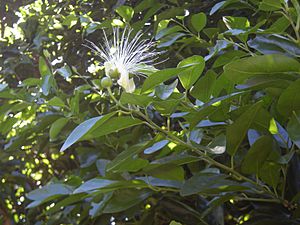Native pomegranate facts for kids
Capparis arborea is a cool plant from eastern Australia. It's often called the native pomegranate, wild lime, wild lemon, or brush caper berry. You can find this bush or small tree growing in rainforest areas, especially near rivers, along the coast, or in drier parts of the rainforest. It grows all the way from the Hunter River in New South Wales up to Cape Melville in sunny Queensland.
Quick facts for kids Native pomegranate |
|
|---|---|
 |
|
| Capparis arborea flower | |
| Scientific classification | |
| Genus: |
Capparis
|
| Species: |
arborea
|
| Synonyms | |
|
Capparis nobilis var. arborea F.Muell. (Endl.) |
|
What Does It Look Like?
This plant can grow up to 8 meters (about 26 feet) tall. Its trunk is often a bit bent and not perfectly straight. When the plant is young, it has many sharp prickles, which are like tiny thorns. As the tree gets older, its grey bark has fewer sharp spines. Its smaller branches are usually thick and dark grey, becoming greener at their tips.
The leaves grow one after another on the stem. They are simple, meaning they are not divided into smaller leaflets. They are shaped like a long oval, sometimes a bit wider at the bottom. Each leaf is about 5 to 10 centimeters (2 to 4 inches) long and 1.5 to 5 centimeters (0.6 to 2 inches) wide. Most leaves have a rounded tip, but some can be pointed. Young leaves are smaller and have a prickly, pointed tip. You can easily see the leaf veins on both sides of the leaf.
Flowers and Fruit
Beautiful white flowers grow one by one from where the leaves meet the stem. Each flower is about 4 centimeters (1.6 inches) wide. These pretty, open, and wiry flowers bloom from January to March. Their petals are about 15 millimeters (0.6 inches) long and have a fringed edge. The thin flower stalks are 30 to 50 millimeters (1.2 to 2 inches) long.
From December to March, the plant grows a fruit that looks a bit like a guava. It's green, smooth, and soft, and shaped like a ball. The fruit is usually 2.5 to 6 centimeters (1 to 2.4 inches) wide. The stalks holding the fruit are 3 to 5 centimeters (1.2 to 2 inches) long. Inside, the seeds are round and flat, about 8 to 10 millimeters (0.3 to 0.4 inches) wide.
When the fruit is ripe, it turns yellow. The soft part around the seeds can be eaten. Aboriginal people used to eat this fruit as a source of food. If you plant fresh seeds, they usually sprout quite easily, with the first seedlings appearing after about three weeks.
Images for kids


